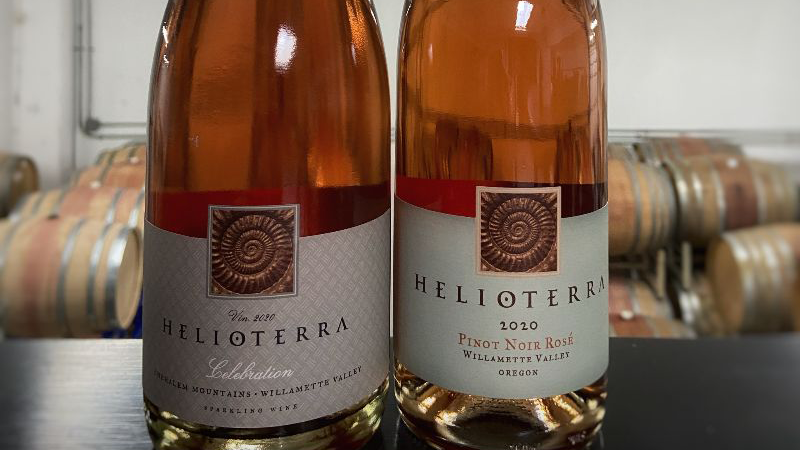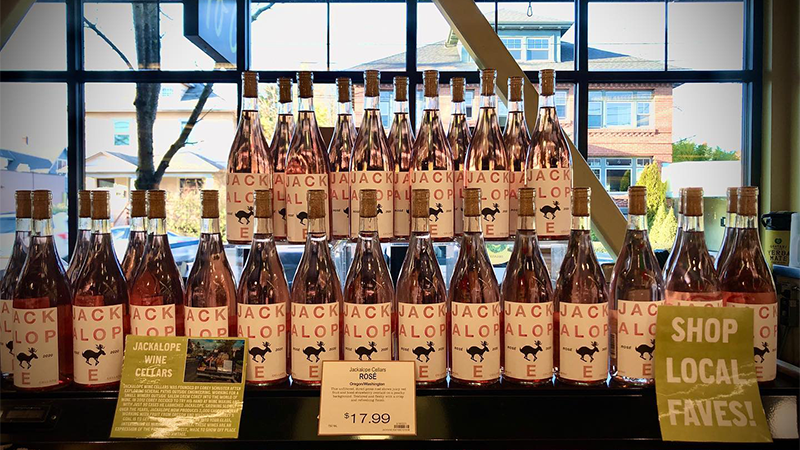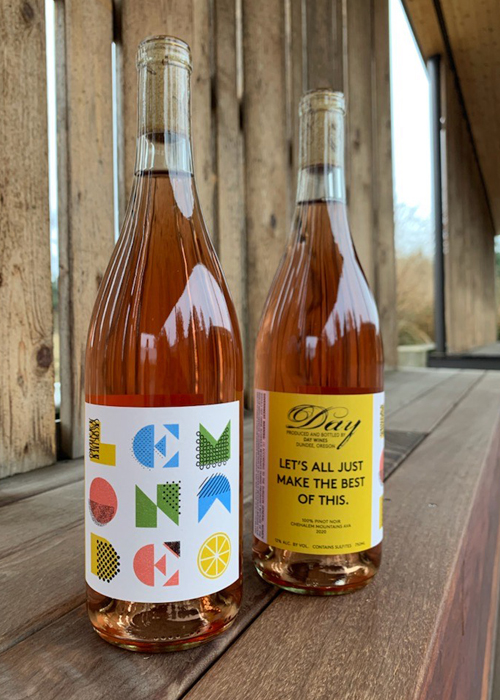Winemakers are a resilient bunch. They must be, of course, given that their main ingredient is subject to unpredictable weather patterns and environmental conditions that impact all agricultural products.
Oregon winemakers are used to dealing with these challenges, wet years especially, and have found ways to minimize the effects of mold and rot. But last year, amid a global pandemic, Oregon was hit with wildfires. It was not the first time Oregon winemakers had to deal with mitigating wildfire smoke damage, which also affected the 2017 and 2018 vintages. But it was one of the first times the state’s winemakers had faced active fires in winemaking regions within southern Oregon and the state’s largest wine-producing region, the Willamette Valley.
For Oregon producers such as Jackalope Wine Cellars, Day Wines, and Helioterra Wines, wildfires brought a new issue to the region that impacted much of the 2020 vintage: smoke taint, or grapes affected by exposure to wildfire smoke. But smoke damage isn’t something winemakers can rinse off of the fruit. Instead, it forced winemakers to develop new plans for the vintage — and resulted in a lot more rosé.
Don’t miss a drop!
Get the latest in beer, wine, and cocktail culture sent straight to your inbox.
When wood burns, it releases aromatic compounds called volatile phenols, which can permeate grape skins and bond with the sugars inside (a process called glycosylation). When fruit is affected by smoke taint, says Corey Schuster, owner and winemaker of Jackalope Wine Cellars in Dundee, Ore., “the chemical gets in the skin of the grape; so when you make wine, the more skin contact, the more of the chemical in that wine.”
That chemical, called guaiacol, is not harmful, but its impact on flavor can create undesirable savory, ashy, smoky, campfire, or even barbecue-like characteristics, depending on the intensity of the smoke and length of exposure. Smoke influence can also affect the texture of wine, giving it a biting astringency, particularly in the finish.
“Even if you don’t smell smoke on the wine, you can still get those textures,” says Brianne Day, winemaker and owner of Day Wines in Dundee. “It’s almost like an intensely drying tannin that also has a banana skin astringency.”
Though Jackalope had planned Grenache and Cabernet Franc styles for its 2020 vintage, Schuster, like several other Oregon winemakers, chose to make rosé to lessen the amount of skin contact and mitigate the effects of smoke-affected grapes. This translated into producing 230 cases of rosé, nearly double the 125 to 150 cases he planned for. In the end, it proved a fruitful decision. Schuster notes that rosé generally sells well, and that his 2020 vintage has almost sold out as of press time.
Without a playbook for dealing with smoke taint, Schuster and his fellow winemakers at other wineries had to figure things out as they went along. To inform what Schuster describes as a “choose-your-own-adventure” approach, he sought advice from friends and winemakers in both Oregon as well as Washington, many of whom were also dealing with smoke-affected grapes from wildfires; he read studies from the Australian Wine Research Institute in a country that has dealt with fires near vineyards and smoke damage since the 1980s; and consulted reports generated by the Oregon Wine Board.
Many winemakers employed techniques outside their usual winemaking processes, such as micro-fermentations, less skin contact (no cold soaks or extended maceration), use of activated carbon, or treatments such as adding yeast or oak, and hoping for the best.

Solving the Smoke Taint Problem
The solution to dealing with smoke-affected grapes is not as simple as making rosé instead of red wine. How the fruit is affected by smoke depends on variables such as the fruit’s stage of ripening; the duration of the smoke exposure; and the type of smoke exposure, which is influenced by its proximity to the fire, how far the smoke had to travel, and the age of the smoke. Sometimes, the true impact of the smoke taint isn’t revealed until after the wine has fermented, anywhere from first sip to nine months’ aging.
This is because there are two types of guaiacol, a free and a bound version, says Day. “Some of the compound is easy to get rid of by pressing lightly or settling the juice out really aggressively,” she says. “But the majority of guaiacol is bound to sugar molecules and it doesn’t get released until the sugar breaks down to make alcohol. So, you won’t know sensorially if you have elevated levels. It’s hard to make decisions.”
And various grapes are affected differently, too: Syrah and Cabernet Sauvignon naturally contain some of the same chemical compounds as smoke, so some of that smoke influence isn’t as apparent as in other grape varieties. More delicate grapes such as Pinot Noir — which accounts for 60 percent of grapes grown in the Willamette Valley — are more impacted.
To better understand what smoke compounds were present in their grapes, some winemakers and growers sent their grapes to testing labs to determine if they contained high levels of guaiacol, the chemical compound associated with smoke taint. This produced its own challenges — with so many wineries sending grapes to get tested, there was a backlog, says Schuster; and besides being time prohibitive, the tests can be expensive to winemakers already facing potential loss.
Winemakers without testing results had to decide whether to take a gamble on the fruit. The three winemakers here agreed it was worth the gamble, not only for their wines but to put a premium on maintaining the working relationships they’ve cultivated with growers.
Schuster works with two vineyards that conducted testing and knew that the fruit had been severely affected. “How do you financially handle that between a grower and a winery like myself?” he says. Jackalope is a small winery, producing 2,000 cases per year. Only one of the growers had fruit that was affected by smoke, and she did not hold Schuster to his contract. “I offered to pay for farming costs for the year to compensate them and she said, ‘Don’t worry about it,’” Schuster says. “It showed me that she thinks our relationship is worth some sacrifice to maintain. And it made me more fiercely loyal to her and her vineyard.”

Schuster says that, so far, his 2020 rosé, a blend of 85 percent Grenache and 15 percent Cabernet Franc, hasn’t shown any discernible smoke taint. Although he’s typically a hands-off winemaker, last year he experimented with different processes and treatments to mitigate smoke impact. Rather than crush the grapes and let the juice marinate in its skins for a few hours to pick up color and some flavor and aromatics, and then press them, the 2020 harvest immediately went into press. From there, Schuster tried a little bit of everything on different batches: adding oak chips to enhance complexity and outshadow the smoke; adding yeast to get the wine to ferment fully and quickly; and adding activated charcoal to stainless-steel ferments. Activated charcoal’s proteins can pull out smoke taint’s chemical compounds, Schuster says, adding, “It was terrifying to do because it looks like black liquid; eventually it comes out.”
All the wine went back into a blend to make a rosé that’s marketed as “a juicy pink that defines crushable.”
While Anne Hubatch, winemaker and owner of Helioterra Wines in Portland, had always planned to make rosé in 2020, she also had to adjust her process. She picked 5-gallon buckets’ worth of grapes and set up 10 micro fermentations in her lab. She crushed whole cluster samples, used the same yeast on all of them, and put heaters in front of the buckets. “I kicked them off with fermentation right away so I could have a ‘finished’ wine within a matter of days,” Hubatch says. “The thing is, in juice, you can’t tell the same things you can tell in wine. Doing that allowed me, and many of us who did this, the ability to start to analyze what each wine from each vineyard would taste like.”
Hubatch brought samples of the pressed juice to taste with the growers. Only one had strong smoke flavor, and although Hubatch wanted to honor their working relationship by purchasing the ton and a half of grapes she was contracted for, she and her supplier mutually agreed that the wine quality wouldn’t be what they wanted. “It was the only contract I didn’t honor,” Hubatch says. The grapes she did purchase to make rosé came from two growers, both of which were smoke-affected but salvageable.
It bodes well that Hubatch aims to make rosé wines that flirt between fruity and savory, like one of her rosés made with 100 percent Pommard. “I choose actively older vines specifically because a signature of Pommard is a certain ashiness,” she sayus. “I used some [high-ester] yeast that brought out strawberry and cream notes, but because of Pommard, I really get a lot of inherently more savory, charcoal, and herbal characteristics from my rosé.” The other rosé, made with old-vine Pinot Noir, was fermented in neutral oak and stainless steel, yielding a wine that’s billed as providing “crisp refreshing fruits and plush weight.”
Hubatch says that producing wines kissed by smoke didn’t bother her. “Terroir is more than just soil and climate. Terroir is all the factors that go into a growing condition. In 2020, our terroir not only included wildfires, but it included a global pandemic,” Hubatch says. “The fact that some of these wines have this smoke signature to me mimics the fact that 2020 was a f*cking dumpster fire. There’s not a single human who didn’t feel that. I love that the wines do have a little bit of this grittiness … that shows the tenacity of the year instead of trying to mask it. I really hope that consumers embrace that piece of it.”
Making Lemonade
Although Oregon winemakers were able to turn lemons into lemonade, so to speak, they are coming to terms with the fact that dealing with wildfires and smoke damage isn’t a one-time thing. On the heels of record-setting, 100-degree-plus temperatures in Oregon and across the Pacific Northwest, there is a new spate of wildfires currently raging at the time of this writing. In addition to bringing the threat of climate change into sharp relief, wildfires have compelled winemakers to examine the fragility of the supply chain and how it impacts the welfare of the industry’s growers and workers, too. These are conversations that Oregon winemakers are having among themselves, but the hope is that rosés made in 2020 help spark conversations for consumers, too.
Day sees an opportunity for these 2020 Oregon rosés to spark conversation among consumers. Last year, Day released the aptly named “Lemonade” rosé, made with 100 precent Pinot Noir grapes, and boldly printed on its side label: “Let’s all just make the best of this.”

“I want to talk more about the realities of climate change, and I want the average person who isn’t in the wine or food industries to see (or taste) a tangible result of climate change,” Day says. “What does it look like in real time? How is it affecting our lives and businesses? How do we behave in response?”
In tandem with that, Day wants to discuss the “human-to-human treatment” in the industry, whether that’s the health and welfare of employees and farm laborers or working with small farmers to support them through a crisis.
Like Hubatch and Schuster, Day made it a priority to purchase and salvage smoke-tainted fruit to maintain working relationships and support suppliers. She printed Chehalem Mountains on the label to highlight that the grapes came from especially hard-hit American Viticultural Areas (AVAs); Day purchased fruit from two small, independent growers who were having difficulty selling their smoke-affected fruit.
Because the smoke blocked the sun in their vineyards, possibly in conjunction with the toxic effects of the smoke, the wildfires stalled ripening. The fruit wasn’t quite ripe enough for red wine, but Day says the chemistries were good for rosé: low pH, ample acid (but not all malic acid, which can impart green, or unripe, flavors in wine and can destabilize pH levels, creating variability in product), and lower sugar. After purchasing the fruit, Day did everything she could to minimize the effect of smoke. The team experimented with pressing the grapes at different pressures, 0.8 bar up to 1.4 bar. Day continually tasted the juice to isolate when she started tasting acrid characteristics. Smoke showed up in the harder-pressed barrels (even though it was still a relatively gentle amount of pressure), so Day got her distillation license and distilled that juice into brandy.
To make Lemonade, Day fermented the juice under 0.8 bar separately from the rest, settled the juice, and racked the wine seven to eight times before filtering it (she doesn’t typically filter wines). “That’s a lot,” Day says, “Like, a lot, lot. I settled out gross lees, then fine lees, racked it while it was fermenting, and moved some into barrels to isolate possible problematic things.” When she released Lemonade in November 2020, she quickly sold out of the 1,200 cases.
In anticipation of tripling production of Lemonade this year, Day added several vineyards to her supplier list with rosé in mind. “It’s wonderful to see the rapid demand happen for a product that came about out of necessity.”
This story is a part of VP Pro, our free content platform and newsletter for the drinks industry, covering wine, beer, and liquor — and beyond. Sign up for VP Pro now!


